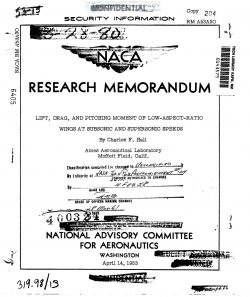naca-rm-a53a30
- Version
- 111 Downloads
- 6.42 MB File Size
- 1 File Count
- August 13, 2017 Create Date
- August 13, 2017 Last Updated
National Advisory Committee for Aeronautics, Research Memorandum - Lift, Drag, and Pitching Moment of Low Aspect Ratio Wings at Subsonic and Supersonic Speeds

Results are presented of a coordinated investigation to evaluate the
lift, drag, and pitching-moment characteristics of thin, low-aspect-ratio
wings in combination with a body. Wind-tunnel data were obtained in the
Mach number range from 0.25 to as high as 1.9.
The investigation of a series of 3-percent-thick triangular wings of
2, 3, and h aspect ratio shOWed that the lift-curve slope was predicted
satisfactorily by linearized theory except near a Mach number of unity
and over portions of the supersonic speed range. As predicted by linear-
ized theory, the aerodynamic center moved aft with increasing Mach number
at subsonic speeds, the over-all travel increasing with aspect ratio. ;_
The data indicated that, in general, it would be more accurate to calcu-
late the drag due to lift at supersonic speeds, assuming that the net_ 1
force due to angle of attack was normal to the wing chord than to use I
available theoretical methods which consider leading—edge thrust.
The investigation of a series of 3—percent—thick wings having swept:
back, unswept, and triangular plan forms of aspect ratios 2 and 3 showéd_
that, as predicted by theory, the lift— —curve slope deereased with increas—
ing sweepback, but with increasing Mach number the effects of plan form
and aspect ratio on the lift- -curve slope diminished and essentially
vanished at the highest supersonic Mach number of the investigation. The
over-all travel of the aerodynamic center decreased with increasing sweep.
The investigation of a series of triangular wings of aspect ratio 2
and thicknesses of 3, 5, and 8 percent showed that the wave drag was pro—
portional to the thickness ratio squared. The drag due to lift decreased
with increase in thickness ratio from 3 percent to 5 percent, the effect
being most pronounced at Mach numbers of 0.9 and below.
A series of wings was investigated to determine the effects of
thickness distribution. The results showed that, in general, wings with
sharp leading edges had a lower value of minimum drag at supersonic
speeds above those estimated for attachment of the bow wave, and a higher
value at subsonic speeds than wings with round leading edges. The effects
of airfoil section on the drag due to lift were small, however.
The results showed that twisting and cambering a triangular wing of
aspect ratio 2 reduced the drag coefficient at a lift coefficient above
0.1. Such benefits of camber and twist did not occur, however, if the
component of the free-stream Mach number perpendicular to the leading edge
exceeded a value of approximately 0.7.
| File | Action |
|---|---|
| naca-rm-a53a30 Lift, Drag, and Pitching Moment of Low Aspect Ratio Wings at Subsonic and Supersonic Speeds.pdf | Download |
Comment On This Post